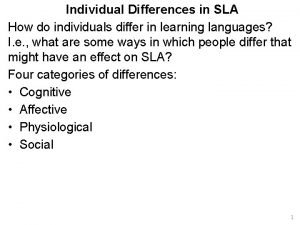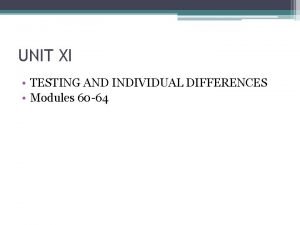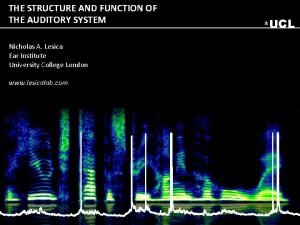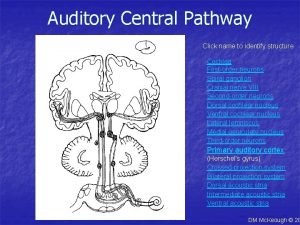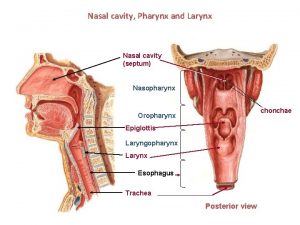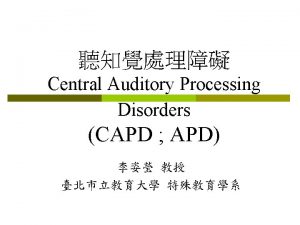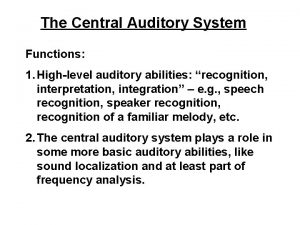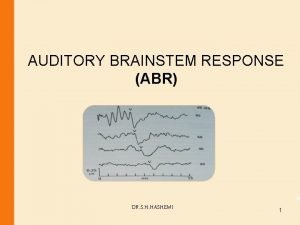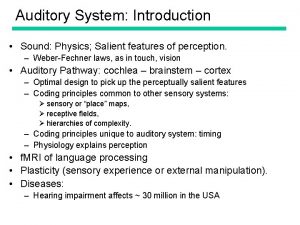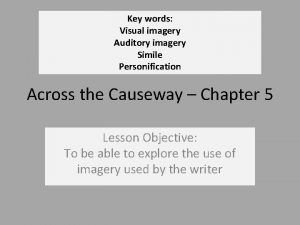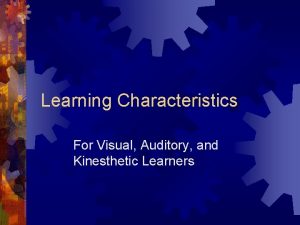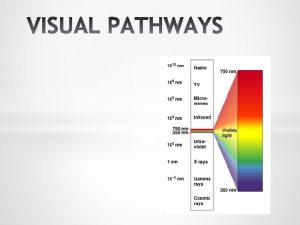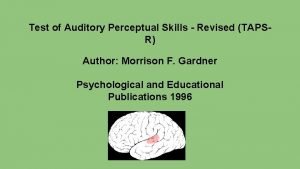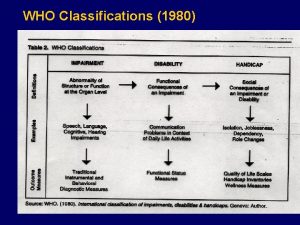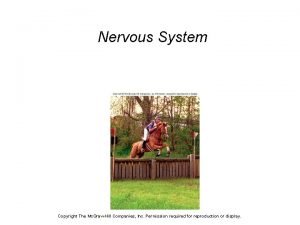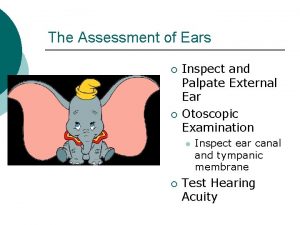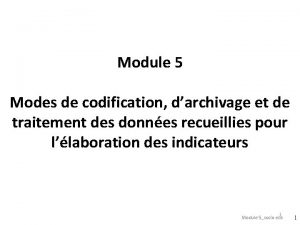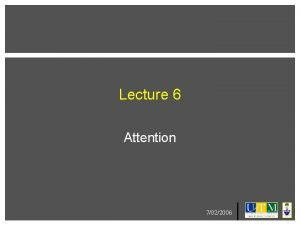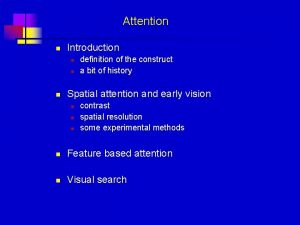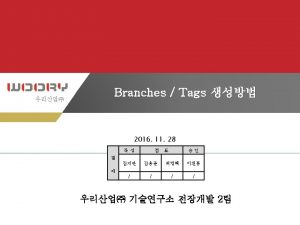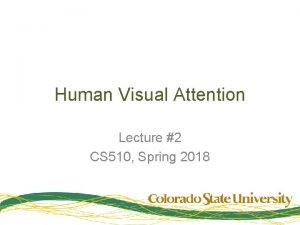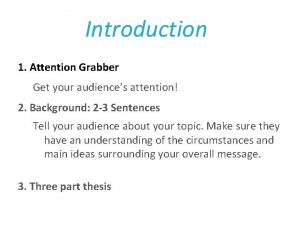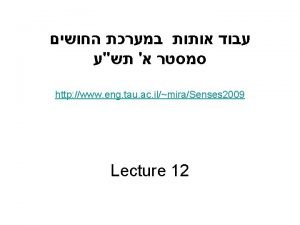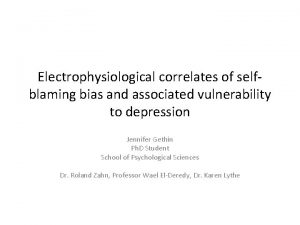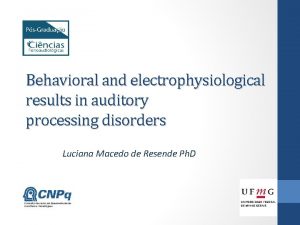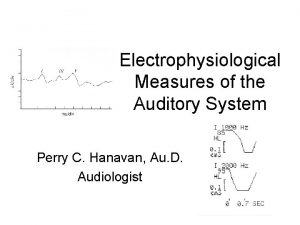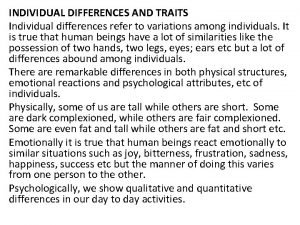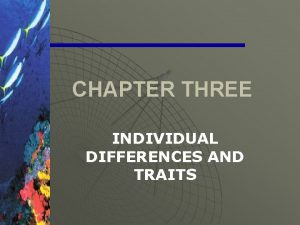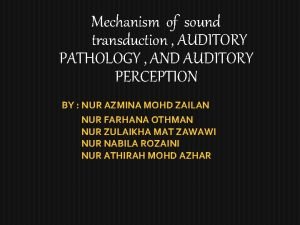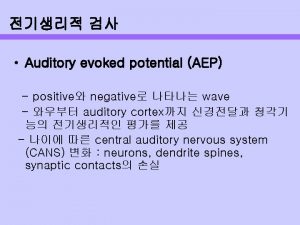Individual differences in electrophysiological correlates of auditory attention































![Pavlovian approach to temperament The Pavlovian Temperament Survey (PTS) [Strelau, 1999]: Pavlovian approach to temperament The Pavlovian Temperament Survey (PTS) [Strelau, 1999]:](https://slidetodoc.com/presentation_image/5823fa19f87abe489958bbf424e956da/image-32.jpg)
![Pavlovian approach to temperament The Pavlovian Temperament Survey (PTS) [Strelau, 1999]: Intensity dimensions: - Pavlovian approach to temperament The Pavlovian Temperament Survey (PTS) [Strelau, 1999]: Intensity dimensions: -](https://slidetodoc.com/presentation_image/5823fa19f87abe489958bbf424e956da/image-33.jpg)
![Pavlovian approach to temperament The Pavlovian Temperament Survey (PTS) [Strelau, 1999]: Intensity dimensions: - Pavlovian approach to temperament The Pavlovian Temperament Survey (PTS) [Strelau, 1999]: Intensity dimensions: -](https://slidetodoc.com/presentation_image/5823fa19f87abe489958bbf424e956da/image-34.jpg)
![Pavlovian approach to temperament The Structure of Temperament Questionnaire (STQ) [Rusalov, 1990, 2002]. Pavlovian approach to temperament The Structure of Temperament Questionnaire (STQ) [Rusalov, 1990, 2002].](https://slidetodoc.com/presentation_image/5823fa19f87abe489958bbf424e956da/image-35.jpg)
![Pavlovian approach to temperament The Structure of Temperament Questionnaire (STQ) [Rusalov, 1990, 2002]. Intensity Pavlovian approach to temperament The Structure of Temperament Questionnaire (STQ) [Rusalov, 1990, 2002]. Intensity](https://slidetodoc.com/presentation_image/5823fa19f87abe489958bbf424e956da/image-36.jpg)
![Pavlovian approach to temperament The Structure of Temperament Questionnaire (STQ) [Rusalov, 1990, 2002]. Intensity Pavlovian approach to temperament The Structure of Temperament Questionnaire (STQ) [Rusalov, 1990, 2002]. Intensity](https://slidetodoc.com/presentation_image/5823fa19f87abe489958bbf424e956da/image-37.jpg)
![Pavlovian approach to temperament The Structure of Temperament Questionnaire (STQ) [Rusalov, 1990, 2002]. Intensity Pavlovian approach to temperament The Structure of Temperament Questionnaire (STQ) [Rusalov, 1990, 2002]. Intensity](https://slidetodoc.com/presentation_image/5823fa19f87abe489958bbf424e956da/image-38.jpg)

![Questionnaires: - EPI (Eysenck Personality Inventory) [Eysenck, 1982; Shmelyov, 2002] - PTS (Pavlovian Temperament Questionnaires: - EPI (Eysenck Personality Inventory) [Eysenck, 1982; Shmelyov, 2002] - PTS (Pavlovian Temperament](https://slidetodoc.com/presentation_image/5823fa19f87abe489958bbf424e956da/image-40.jpg)





















![Questionnaires: - EPI (Eysenck Personality Inventory) [Eysenck, 1982; Shmelyov, 2002] - PTS (Pavlovian Temperament Questionnaires: - EPI (Eysenck Personality Inventory) [Eysenck, 1982; Shmelyov, 2002] - PTS (Pavlovian Temperament](https://slidetodoc.com/presentation_image/5823fa19f87abe489958bbf424e956da/image-62.jpg)
![Questionnaires: - EPI (Eysenck Personality Inventory) [Eysenck, 1982; Shmelyov, 2002] - PTS (Pavlovian Temperament Questionnaires: - EPI (Eysenck Personality Inventory) [Eysenck, 1982; Shmelyov, 2002] - PTS (Pavlovian Temperament](https://slidetodoc.com/presentation_image/5823fa19f87abe489958bbf424e956da/image-63.jpg)























- Slides: 86

Individual differences in electrophysiological correlates of auditory attention B. V. Chernyshev*, D. M. Ramendik, I. E. Lazarev, E. S. Osokina, N. A. Novikov National Research University Higher School of Economics Laboratory of cognitive psychophysiology Moscow, Russia The study was implemented in the framework of the Basic Research Program at the National Research University Higher School of Economics in 2011 -2014.

What is temperament? Temperament is a set of genetically determined and stable biological characteristics that shape various aspects of behavior and mental processes [Eysenck, 1970; Gray, 1991; Costa, & Mc. Crae, 1995; Rusalov, 2002; Strelau et al. , 2005] – thus leading to characteristic coping strategies.

What is attention? Attention is a mechanism to single out important signals from the immense torrent of stimuli coming from the environment, analyze them and timely respond to them.

What is attention? Attention is a mechanism to single out important signals from the immense torrent of stimuli coming from the environment, analyze them and timely respond to them. Attentional tasks involving active responses create moderately high cognitive load, require effort and thus require participants to choose strategies likely dependent upon temperament. This makes attentional tasks relevant in the search of psychophysiological markers of temperament.

Some relevant finding on relations between temperament and ERPs to auditory stimuli in attentional tasks ♦ The N 1 and N 1 -P 2 amplitude are higher in introverts compared to extraverts [Stelmack, Achorn, & Michaud, 1977; Doucet, & Stelmack, 2000]. ♦ The N 1 peak and N 1 -P 2 amplitude are related to Sensation Seeking and Neuroticism [Doucet, & Stelmack, 2000; Hegerl, Gallinat, & Mrowinski, 1995; Philipova, 2008]. ♦ N 2 amplitude is positively correlated with Anxiety [Righi, Mecacci, & Viggiano, 2009]. ♦ P 3 amplitude is negatively correlated with Neuroticism [Gurrera et al. , 2005], although other authors found no difference [Fjell, Walhovd, Meling, & Johansen, 2005].

Some relevant finding on relations between temperament and ERPs to auditory stimuli in attentional tasks ♦ Some studies reported that higher Extraversion corresponds to higher P 3 amplitude [Gurrera, Salisbury, O’Donnell, Nestor, & Mc. Carley, 2005; Philipova, 2008; Gurrera, O’Donnell, Nestor, Gainski, & Mc. Carley, 2001; Fishman, Ng, & Bellugi, 2011; Cahill, & Polich, 1992], whereas other studies reported the opposite [Daruna, Karrer, & Rosen, 1985; Tatalović Vorkapić, 2009; Beauducel, Brocke, & Leue, 2006; Hansenne, 2000; Wilson, & Languis, 1990] or failed to find any influence of Extraversion on P 3 amplitude [Camposano, Alvarez, & Lolas, 1994]. ♦ P 3 amplitude habituates faster in extraverts, thus making the amplitude dependent on the duration of the experiment [Ditraglia, & Polich 1991].

Hot questions

Hot questions ♦ How many temperament dimensions actually exist?

Hot questions ♦ How many temperament dimensions actually exist? ♦ Altogether more than 80 temperament dimensions were proposed.

Hot questions ♦ How many temperament dimensions actually exist? ♦ Altogether more than 80 temperament dimensions were proposed. ♦ Questionnaires may probe 2 to 16 dimensions at a time.

Hot questions ♦ How many temperament dimensions actually exist? ♦ Altogether more than 80 temperament dimensions were proposed. ♦ Questionnaires may probe 2 to 16 dimensions at a time. ♦ Can it be that we still do not know the “true” temperament dimensions, and we actually use projections of this multidimensional space onto more or less arbitrary axes?

Hot questions ♦ How many temperament dimensions actually exist? ♦ Altogether more than 80 temperament dimensions were proposed. ♦ Questionnaires may probe 2 to 16 dimensions at a time. ♦ Can it be that we still do not know the “true” temperament dimensions, and we actually use projections of this multidimensional space onto more or less arbitrary axes? ♦ Can it be that the number of temperament dimensions is much grater than currently known?

Hot questions

Hot questions ♦ Currently many temperament dimension were traced to particular genes coding particular proteins involved in neuromodulatory systems: serotonin - anxiety, dopamine – sensation-seeking and extraversion, etc. [reviewed in Ebstein, 2006; Munafò, Flint, 2011]

Hot questions ♦ Currently many temperament dimension were traced to particular genes coding particular proteins involved in neuromodulatory systems: serotonin - anxiety, dopamine – sensation-seeking and extraversion, etc. [reviewed in Ebstein, 2006; Munafò, Flint, 2011] ♦ Taking into account, that there at least hundreds of proteins involved in neuromodulator synthesis, transportation, release, detection by receptors, reuptake and breakdown, there potentially might be hundreds of temperament dimensions in such physiological/biochemical aspect [Munafò, Flint, 2011].

Hot questions ♦ Currently many temperament dimension were traced to particular genes coding particular proteins involved in neuromodulatory systems: serotonin - anxiety, dopamine – sensation-seeking and extraversion, etc. [reviewed in Ebstein, 2006; Munafò, Flint, 2011] ♦ Taking into account, that there at least hundreds of proteins involved in neuromodulator synthesis, transportation, release, detection by receptors, reuptake and breakdown, there potentially might be hundreds of temperament dimensions in such physiological/biochemical aspect [Munafò, Flint, 2011]. ♦ Important analogy: In psychophysical studying of olfaction, 5 to 12 basic smells were proposed by various authors…. Genetical methods revealed about 1000 [Buck, Axel, 1991].

Hot questions

Hot questions ♦ Phenotype may significantly override genetical predispositions, resulting in less variation, because individuals develop certain coping strategies and expectations, and there are not so many general strategies that can be used in real life.

Hot questions ♦ Phenotype may significantly override genetical predispositions, resulting in less variation, because individuals develop certain coping strategies and expectations, and there are not so many general strategies that can be used in real life. ♦ Self-regulation related to attentional networks was proposed [Posner, Rothbart, 1998, 2000].

Hot questions ♦ Phenotype may significantly override genetical predispositions, resulting in less variation, because individuals develop certain coping strategies and expectations, and there are not so many general strategies that can be used in real life. ♦ Self-regulation related to attentional networks was proposed [Posner, Rothbart, 1998, 2000]. ♦ Can it be that temperament dimensions form clusters of related dimensions as a result of trial-and-error learning to use specific coping strategies? This would allow using small numbers of dimensions in description of temperament.

Hot questions ♦ Phenotype may significantly override genetical predispositions, resulting in less variation, because individuals develop certain coping strategies and expectations, and there are not so many general strategies that can be used in real life. ♦ Self-regulation related to attentional networks was proposed [Posner, Rothbart, 1998, 2000]. ♦ Can it be that temperament dimensions form clusters of related dimensions as a result of trial-and-error learning to use specific coping strategies? This would allow using small numbers of dimensions in description of temperament. ♦ Naturally occurring clustering would invoke strong correlations between certain dimensions. For example, extraversion is known to have strong positive correlations with the Strength Excitation and Mobility in the Pavlovian theory of temperament [Strelau et al. , 2005].

Discordant patterns of temperament

Discordant patterns of temperament Can it be that some individuals fail to form such coherent patterns of strategies, expectations and self-awareness through experience? ♦

Discordant patterns of temperament Can it be that some individuals fail to form such coherent patterns of strategies, expectations and self-awareness through experience? ♦ Dina M. Ramendik, member of our research group, proposed that a subpopulation of people with discordant patterns of temperament dimensions may be detected in the following way [Ramendik, 2008; Chernyshev et al. , 2010; Ramendik, 2011]: ♦

Discordant patterns of temperament Can it be that some individuals fail to form such coherent patterns of strategies, expectations and self-awareness through experience? ♦ Dina M. Ramendik, member of our research group, proposed that a subpopulation of people with discordant patterns of temperament dimensions may be detected in the following way [Ramendik, 2008; Chernyshev et al. , 2010; Ramendik, 2011]: - several questionnaires need to be used simultaneously ♦

Discordant patterns of temperament Can it be that some individuals fail to form such coherent patterns of strategies, expectations and self-awareness through experience? ♦ Dina M. Ramendik, member of our research group, proposed that a subpopulation of people with discordant patterns of temperament dimensions may be detected in the following way [Ramendik, 2008; Chernyshev et al. , 2010; Ramendik, 2011]: - several questionnaires need to be used simultaneously - questionnaires should be based on significantly different theoretical grounds, but at least some dimensions should be strongly correlated between questionnaires. ♦

Discordant patterns of temperament Can it be that some individuals fail to form such coherent patterns of strategies, expectations and self-awareness through experience? ♦ Dina M. Ramendik, member of our research group, proposed that a subpopulation of people with discordant patterns of temperament dimensions may be detected in the following way [Ramendik, 2008; Chernyshev et al. , 2010; Ramendik, 2011]: - several questionnaires need to be used simultaneously - questionnaires should be based on significantly different theoretical grounds, but at least some dimensions should be strongly correlated between questionnaires. - minor differences in questionnaires may produce reversal of correlational patterns within some individuals, thus uncovering the discordant pattern of temperamental traits in them. ♦

The causes of discordance may presumably include the following:

The causes of discordance may presumably include the following: - Strong environmental pressure making people use coping strategies contradicting those they would naturally develop in free trial-and-error conditions. For example, very oppressive traditional or religious families me make an extraverted person behave and feel introverted.

The causes of discordance may presumably include the following: - Strong environmental pressure making people use coping strategies contradicting those they would naturally develop in free trial-and-error conditions. For example, very oppressive traditional or religious families me make an extraverted person behave and feel introverted. - Inborn high reactivity may lead to anxiety. In most people this anxiety dissipates with time, but it prevents normal communication with pears and causes some kind of learned helplessness in sociability. Thus the questionnaires may falsely detect such people as introverts, while other dimensions would show that the person might actually be a hidden extravert.

Longitudinal study has shown that discordant individuals are much less successful in education and carrier, and this factor is more important than IQ and a number of other intellect and attention measures [Ramendik, 2011; Ramendik, Chernysheva, 2014]. ♦ Ramendik, Chernysheva, 2014. Voprosy psihologii, 2014, 3, 105 -117
![Pavlovian approach to temperament The Pavlovian Temperament Survey PTS Strelau 1999 Pavlovian approach to temperament The Pavlovian Temperament Survey (PTS) [Strelau, 1999]:](https://slidetodoc.com/presentation_image/5823fa19f87abe489958bbf424e956da/image-32.jpg)
Pavlovian approach to temperament The Pavlovian Temperament Survey (PTS) [Strelau, 1999]:
![Pavlovian approach to temperament The Pavlovian Temperament Survey PTS Strelau 1999 Intensity dimensions Pavlovian approach to temperament The Pavlovian Temperament Survey (PTS) [Strelau, 1999]: Intensity dimensions: -](https://slidetodoc.com/presentation_image/5823fa19f87abe489958bbf424e956da/image-33.jpg)
Pavlovian approach to temperament The Pavlovian Temperament Survey (PTS) [Strelau, 1999]: Intensity dimensions: - Strength of Excitation (the ability to endure arousing environmental influences; α =. 82), - Strength of Inhibition (the ability to endure inhibiting environmental influences; α =. 84),
![Pavlovian approach to temperament The Pavlovian Temperament Survey PTS Strelau 1999 Intensity dimensions Pavlovian approach to temperament The Pavlovian Temperament Survey (PTS) [Strelau, 1999]: Intensity dimensions: -](https://slidetodoc.com/presentation_image/5823fa19f87abe489958bbf424e956da/image-34.jpg)
Pavlovian approach to temperament The Pavlovian Temperament Survey (PTS) [Strelau, 1999]: Intensity dimensions: - Strength of Excitation (the ability to endure arousing environmental influences; α =. 82), - Strength of Inhibition (the ability to endure inhibiting environmental influences; α =. 84), Temporal dimension: - Mobility of Nervous Processes (the speed of alteration of excitation and inhibition processes; α =. 81).
![Pavlovian approach to temperament The Structure of Temperament Questionnaire STQ Rusalov 1990 2002 Pavlovian approach to temperament The Structure of Temperament Questionnaire (STQ) [Rusalov, 1990, 2002].](https://slidetodoc.com/presentation_image/5823fa19f87abe489958bbf424e956da/image-35.jpg)
Pavlovian approach to temperament The Structure of Temperament Questionnaire (STQ) [Rusalov, 1990, 2002].
![Pavlovian approach to temperament The Structure of Temperament Questionnaire STQ Rusalov 1990 2002 Intensity Pavlovian approach to temperament The Structure of Temperament Questionnaire (STQ) [Rusalov, 1990, 2002]. Intensity](https://slidetodoc.com/presentation_image/5823fa19f87abe489958bbf424e956da/image-36.jpg)
Pavlovian approach to temperament The Structure of Temperament Questionnaire (STQ) [Rusalov, 1990, 2002]. Intensity dimensions: - Object-related Ergonicity (the disposition to perform mental and physical work; α =. 83), - Social Ergonicity (the disposition to be involved in social activity; α =. 76),
![Pavlovian approach to temperament The Structure of Temperament Questionnaire STQ Rusalov 1990 2002 Intensity Pavlovian approach to temperament The Structure of Temperament Questionnaire (STQ) [Rusalov, 1990, 2002]. Intensity](https://slidetodoc.com/presentation_image/5823fa19f87abe489958bbf424e956da/image-37.jpg)
Pavlovian approach to temperament The Structure of Temperament Questionnaire (STQ) [Rusalov, 1990, 2002]. Intensity dimensions: - Object-related Ergonicity (the disposition to perform mental and physical work; α =. 83), - Social Ergonicity (the disposition to be involved in social activity; α =. 76), Temporal dimensions: - Object-related Plasticity (the ease of switching from one object-related activity to another; α =. 77), - Social Plasticity (the ease of entering in social contacts and the diversity of communicative programs; α =. 72), - Object-related Tempo (the speed of mental operations and motor acts in the process of objectrelated activity; α =. 80), - Social Tempo (the speed of mental operations and motor acts in the process of communication; α =. 73),
![Pavlovian approach to temperament The Structure of Temperament Questionnaire STQ Rusalov 1990 2002 Intensity Pavlovian approach to temperament The Structure of Temperament Questionnaire (STQ) [Rusalov, 1990, 2002]. Intensity](https://slidetodoc.com/presentation_image/5823fa19f87abe489958bbf424e956da/image-38.jpg)
Pavlovian approach to temperament The Structure of Temperament Questionnaire (STQ) [Rusalov, 1990, 2002]. Intensity dimensions: - Object-related Ergonicity (the disposition to perform mental and physical work; α =. 83), - Social Ergonicity (the disposition to be involved in social activity; α =. 76), Temporal dimensions: - Object-related Plasticity (the ease of switching from one object-related activity to another; α =. 77), - Social Plasticity (the ease of entering in social contacts and the diversity of communicative programs; α =. 72), - Object-related Tempo (the speed of mental operations and motor acts in the process of objectrelated activity; α =. 80), - Social Tempo (the speed of mental operations and motor acts in the process of communication; α =. 73), Emotionality dimensions: - Object-related Emotionality (the emotional sensitivity to discrepancies between anticipated and real results of object-related activity; α =. 84), - Social Emotionality (the emotional sensitivity to failures in communication; α =. 71).

Study 1 Aims: - To find psychophysiological evidence that Extraversion is not a unitary dimension - To find psychophysiological markers distinguishing individuals with the discordant structure of temperament Chernyshev, Lazarev, Chernysheva, 2013. Psychology & Neuroscience, V. 6, No 3, p. 235 -245 Ramendik, Chernysheva, 2014. Voprosy psihologii, 2014, 3, 105 -117
![Questionnaires EPI Eysenck Personality Inventory Eysenck 1982 Shmelyov 2002 PTS Pavlovian Temperament Questionnaires: - EPI (Eysenck Personality Inventory) [Eysenck, 1982; Shmelyov, 2002] - PTS (Pavlovian Temperament](https://slidetodoc.com/presentation_image/5823fa19f87abe489958bbf424e956da/image-40.jpg)
Questionnaires: - EPI (Eysenck Personality Inventory) [Eysenck, 1982; Shmelyov, 2002] - PTS (Pavlovian Temperament Survey) [Strelau, 1999] - STQ (Structure of Temperament Questionnaire) [Rusalov, 1990, 2002]

Modification of the oddball paradigm (Sutton et al. , 1965) S 2, S 1, S 2, S 2, S 1, S 2…

Modification of the oddball paradigm (Sutton et al. , 1965) S 2, S 1, S 2, S 2, S 1, S 2… Deviants 1050 Hz, standards 1000 Hz, 40 ms (including 10 ms rise and fall), 85 d. B, probability 1: 4, ISI 2, 500 ± 500 ms 15 pericentral electrodes (F 3, Fz, F 4, Fc 3, Fcz, Fc 4, C 3, Cz, C 4, Cp 3, Cpz, Cp 4, P 3, Pz, P 4). Statistics: general linear model, and Spearman correlation. For statistical validization bootstrapping and jackknifing procedures were used.

Grand-averaged ERPs (N=30) -10 N 1 Potential, μV -5 N 2 0 5 10 P 2 -200 0 P 3 200 400 Time, ms 600

The higher Extraversion, the smaller N 1 -P 2 amplitude (F(1, 28)=8. 80, p=. 006, R=-053, p=. 003). -10 -5 0 5 10 200 Time, ms 400 This finding is in line with several reports [Stelmack, Achorn, & Michaud, 1977; Doucet, & Stelmack, 2000]. 600 35 N 1 -P 2 amplitude (u. V) - N 1 -P 2 amplitude (u. V) Potential, μV high Extraversion low Extraversion 30 25 20 15 10 50 10 20 30 40 50 60 70 80 90 100 Extraversion

The higher Mobility, the smaller N 1 -P 2 amplitude (F(1, 28)=8. 50, p=. 007, R=-. 44, p=. 02). high Mobility of nervous processes low Mobility of nervous processes -5 0 5 10 0 200 Time, ms 400 600 35 N 1 -P 2 amplitude (u. V) 200 - N 1 -P 2 amplitude (u. V) Potential, μV - 10 30 25 20 15 10 5 45 50 55 60 65 70 75 80 85 90 95 Mobility of nervous processes

Extraversion and Mobility of nervous process was also similarly related to N 1 amplitude -5 -10 -15 -20 0 10 20 30 40 50 60 70 80 90 100 Extraversion 0 N 1 amplitude (u. V) (F(1, 28)=4. 96, p=. 03, R=. 46, p=. 01) and (F(1, 28)=6. 50, p=. 02, R=. 37, p=. 04) -5 -10 -15 -20 45 50 55 60 65 70 75 80 85 90 95 Mobility of nervous processes

Extraversion and Mobility of nervous process was also similarly related to N 1 amplitude -5 -10 -15 -20 0 10 20 30 40 50 60 70 80 90 100 Extraversion 0 N 1 amplitude (u. V) (F(1, 28)=4. 96, p=. 03, R=. 46, p=. 01) and (F(1, 28)=6. 50, p=. 02, R=. 37, p=. 04) -5 -10 -15 -20 45 50 55 60 65 70 75 80 85 90 95 Mobility of nervous processes Thus, the higher Extraversion and Mobility, the less N 1 and N 1 -P 2 amplitude

The higher Extraversion, the shorter latency of N 2 high Extraversion low Extraversion -10 -5 0 5 10 200 Time, ms 400 600 350 N 2 latecy (ms) - N 2 latency (ms) Potential, μV (F(1, 28)=6. 93, p=. 01, R=-. 46, p=. 01) 300 250 200 150 0 10 20 30 40 50 60 70 80 90 100 Extraversion

The higher Social Ergonicity, the shorter latency of N 2 (F(1, 28)=12. 40, p=. 001, R=-. 55, p=. 001) high social-related ergonicity low social-related ergonicity Potential, μV -10 -5 0 5 10 -200 0 200 400 Time, ms 600 Thus, the higher Extraversion and Social Ergonicity the shorter latency of N 2 latecy (ms) N 2 latency (ms) 350 300 250 200 150 0 2 4 6 8 10 12 Social-related ergonicity 14

Interim summary 1

Interim summary 1 ♦ We found that Extraversion was related to different ERP parameters, each time in complex with another dimension. Together with Mobility of Nervous Processes, Extraversion was related to the amplitude of the N 1 -P 2 complex. Together with Social Ergonicity, Extraversion was related to N 2 latency.

Interim summary 1 ♦ We found that Extraversion was related to different ERP parameters, each time in complex with another dimension. Together with Mobility of Nervous Processes, Extraversion was related to the amplitude of the N 1 -P 2 complex. Together with Social Ergonicity, Extraversion was related to N 2 latency. ♦ Thus, Extraversion manifests itself in two different ways – both as a temporal dimension and as an intensity dimension of temperament. This finding is in line with the data showing that Extraversion combines both intensity and temporal aspects of temperament [Strelau et al. , 2005; Ilyin, 2004; Golubeva, 2005; Beauducel et al. , 2006].

Interim summary 1 ♦ We found that Extraversion was related to different ERP parameters, each time in complex with another dimension. Together with Mobility of Nervous Processes, Extraversion was related to the amplitude of the N 1 -P 2 complex. Together with Social Ergonicity, Extraversion was related to N 2 latency. ♦ Thus, Extraversion manifests itself in two different ways – both as a temporal dimension and as an intensity dimension of temperament. This finding is in line with the data showing that Extraversion combines both intensity and temporal aspects of temperament [Strelau et al. , 2005; Ilyin, 2004; Golubeva, 2005; Beauducel et al. , 2006]. ♦ Temporal aspect: Supposedly smaller amplitude of N 1 -P 2 и N 1 reflects less resources involved in preattentional stages of perception, thus allowing to divide resources between greater number of potential targets of attention. This makes attentional system more effective in finding targets and switching to them – leading to higher Extraversion and higher Mobility

Interim summary 1 ♦ We found that Extraversion was related to different ERP parameters, each time in complex with another dimension. Together with Mobility of Nervous Processes, Extraversion was related to the amplitude of the N 1 -P 2 complex. Together with Social Ergonicity, Extraversion was related to N 2 latency. ♦ Thus, Extraversion manifests itself in two different ways – both as a temporal dimension and as an intensity dimension of temperament. This finding is in line with the data showing that Extraversion combines both intensity and temporal aspects of temperament [Strelau et al. , 2005; Ilyin, 2004; Golubeva, 2005; Beauducel et al. , 2006]. ♦ Temporal aspect: Supposedly smaller amplitude of N 1 -P 2 и N 1 reflects less resources involved in preattentional stages of perception, thus allowing to divide resources between greater number of potential targets of attention. This makes attentional system more effective in finding targets and switching to them – leading to higher Extraversion and higher Mobility ♦ Intensity aspect: faster N 2 may mean faster involvement of cognitive control [Folstein, Van, 2008; Steinhauser, Eichele et al. , 2012], leading again to higher Extraversion and higher Ergonicity.

Measurement of concordance The participants were divided into two groups: “concordant” and “discordant” depending upon the compatibility of temperament profiles for the three questionnaires [Ramendik, 2008; 2011].

Measurement of concordance The participants were divided into two groups: “concordant” and “discordant” depending upon the compatibility of temperament profiles for the three questionnaires [Ramendik, 2008; 2011]. For the analysis mean values (М) of a dimension and its dispersion (δ) were taken from the original validation papers [Eysenck, 1985; Rusalov, 1990; Strelau et al. , 1999]. Experimentally measured values were thus classified as low (less then М-δ), medium (within М±δ), and high (greater then М+δ). Within the known correlational ties reported by questionnaire authors, the results for each participant were evaluated pairwise as compatible (same or near correspondence) or incompatible (opposite groups). For “concordant” participants all measures were in agreement with known correlations, for discordant participants at least one measure contradicted known correlations.

In concordant group (N=16) amplitude of N 2 -P 3 higher, then in discordant group (N=14) (F(1, 28)=11. 79, p=. 002) -15 Potential, μV -10 -5 0 5 Fcz 10 15 -200 0 200 Time, ms “discordant" “concordant" 400 600

Interim summary 2

Interim summary 2 ♦ We found that concordant and discordant groups manifested ERP difference that can not be explained through any single dimension, and thus the distinction of concordant/discordant structures of temperament is a separate phenomenon.

Interim summary 2 ♦ We found that concordant and discordant groups manifested ERP difference that can not be explained through any single dimension, and thus the distinction of concordant/discordant structures of temperament is a separate phenomenon. ♦ Lower N 2 -P 3 amplitude may mean poorer cognitive control and/or attention in discordant individuals.

Study 2 Aims: - To find the psychophysiological precursors of spontaneous attention errors - To find psychophysiological markers distinguishing individuals with the discordant structure of temperament Partially data on errors published in: Lazarev, Bryzgalov, Osokina, Vyazovtseva, Antonenko, Arkhipova, Chernyshev. Zhurnal Vyss Nervn Deyatelnosti, 64, 3, 292 -303.
![Questionnaires EPI Eysenck Personality Inventory Eysenck 1982 Shmelyov 2002 PTS Pavlovian Temperament Questionnaires: - EPI (Eysenck Personality Inventory) [Eysenck, 1982; Shmelyov, 2002] - PTS (Pavlovian Temperament](https://slidetodoc.com/presentation_image/5823fa19f87abe489958bbf424e956da/image-62.jpg)
Questionnaires: - EPI (Eysenck Personality Inventory) [Eysenck, 1982; Shmelyov, 2002] - PTS (Pavlovian Temperament Survey) [Strelau, 1999] - NEO-FFI [Costa, Mc. Crae, 1995; Orel, Senin, 2008].
![Questionnaires EPI Eysenck Personality Inventory Eysenck 1982 Shmelyov 2002 PTS Pavlovian Temperament Questionnaires: - EPI (Eysenck Personality Inventory) [Eysenck, 1982; Shmelyov, 2002] - PTS (Pavlovian Temperament](https://slidetodoc.com/presentation_image/5823fa19f87abe489958bbf424e956da/image-63.jpg)
Questionnaires: - EPI (Eysenck Personality Inventory) [Eysenck, 1982; Shmelyov, 2002] - PTS (Pavlovian Temperament Survey) [Strelau, 1999] - NEO-FFI [Costa, Mc. Crae, 1995; Orel, Senin, 2008]. Groups: Concordant (N=44), Discordant (N=7)

Correlation matrix between personality dimensions (N=70). In color are shown significant correlations (p<. 001): blue – negative, pink - positive

Modification of a condensation task (Posner, 1964) Four auditory stimuli, each characterized with two features (pitch and noisiness), and the following response contingencies in the experimental task: Pure Noised High Left button Right button Low Right button Left button

Modification of a condensation task (Posner, 1964) Four auditory stimuli, each characterized with two features (pitch and noisiness), and the following response contingencies in the experimental task: HP, LP, Pure Noised High Left button Right button Low Right button Left button LN, HN, LP, LN, HP…

Modification of a condensation task (Posner, 1964) Four auditory stimuli, each characterized with two features (pitch and noisiness), and the following response contingencies in the experimental task: HP, LP, Pure Noised High Left button Right button Low Right button Left button LN, HN, LP, LN, Low 500 Hz, high 2000 Hz, 40 ms (including 10 ms rise and fall), 95 d. B, probability 1: 1: 1: 1, ISI 2, 500 ± 500 ms HP…

P 2 is greater for errors compared to correct responses (N = 52, F(1, 51) = 24. 516, p <. 0001) Difference map (correct-error)

Interim summary 3 ♦ We found that errors are preceded by increased P 2 amplitude. ♦ This may be the consequence of the primary task loosing competition for attentional resources to some covert activity.

Discordant participants committed more errors than concordant ones F(1, 73)=4. 2382, p=. 04

If concordance is not accounted in the analysis, N 1 amplitude does not differ between errors and correct responses (F(1, 51)=2. 901, p=. 09).

If concordance is not accounted in the analysis, N 1 amplitude does not differ between errors and correct responses (F(1, 51)=2. 901, p=. 09). When concordance is included into the analysis, significant are - N 1 amplitude (F(1, 49)=9. 076, p=. 004) - interaction N 1 amplitude x concordance (F(1, 49)=6. 477, p=. 014)

If concordance is not accounted in the analysis, P 2 latency does not differ between errors and correct responses (F(1, 51)=0. 0128, p=. 9).

If concordance is not accounted in the analysis, P 2 latency does not differ between errors and correct responses (F(1, 51)=0. 0128, p=. 9). When concordance is included into the analysis, significant is interaction P 2 latency x concordance (F(1, 49)=5. 553, p=. 02)

Interim summary 4

Interim summary 4 ♦ Again, discordant group proved to be distinguishable from the concordant group.

Interim summary 4 ♦ Again, discordant group proved to be distinguishable from the concordant group. ♦ Apparently, discordant individuals achieve correct responses by investing more effort/resources. Still they can not constantly keep this high level of effort, and by occasionally loosing this level of effort they commit errors.

Interim summary 4 ♦ Again, discordant group proved to be distinguishable from the concordant group. ♦ Apparently, discordant individuals achieve correct responses by investing more effort/resources. Still they can not constantly keep this high level of effort, and by occasionally loosing this level of effort they commit errors. ♦ Concordant individuals invest less effort/resources, with no such evident signs of recoil.

Conclusions

Conclusions ♦ Current findings point to the importance of using a multidimensional approach in the psychophysiological studies of temperament

Conclusions ♦ Current findings point to the importance of using a multidimensional approach in the psychophysiological studies of temperament ♦ Dimensions known as “unitary” may in fact be spitted into several physiologically valid dimensions

Conclusions ♦ Current findings point to the importance of using a multidimensional approach in the psychophysiological studies of temperament ♦ Dimensions known as “unitary” may in fact be spitted into several physiologically valid dimensions ♦ The number of true temperament dimensions is not known, and it is reasonable to expect very high numbers of them

Conclusions ♦ Current findings point to the importance of using a multidimensional approach in the psychophysiological studies of temperament ♦ Dimensions known as “unitary” may in fact be spitted into several physiologically valid dimensions ♦ The number of true temperament dimensions is not known, and it is reasonable to expect very high numbers ♦ Most people adapt through individual trial-and-error learning, and adhere to a limited number of coping strategies – thus making it realistic to approximate temperament of most people with a small number of dimensions

Conclusions ♦ Current findings point to the importance of using a multidimensional approach in the psychophysiological studies of temperament ♦ Dimensions known as “unitary” may in fact be spitted into several physiologically valid dimensions ♦ The number of true temperament dimensions is not known, and it is reasonable to expect very high numbers ♦ Most people adapt through individual trial-and-error learning, and adhere to a limited number of coping strategies – thus making it realistic to approximate temperament of most people with a small number of dimensions ♦ A fraction of the population individual learning partly fails due to external or internal factors. Such individuals have untypical relations within multidimensional temperament space, making them different from the rest of the population (usually with negative effects on academic and professional success even if they possess high cognitive abilities).

Research team Dina M. Ramendik Dmitri V. Bryzgalov Ivan E. Lazarev Anastasia S. Antonenko Evgenia S. Osokina Elena A. Arkhipova Nikita A. Novikov Galiya R. Khusyainova

Thank you for your attention!
 Correlates of effective schools
Correlates of effective schools Michelle benjamin phd
Michelle benjamin phd What are type a people
What are type a people Principles of training individual differences
Principles of training individual differences Individual differences factors
Individual differences factors Individual differences in sla
Individual differences in sla Managing individual differences and behavior
Managing individual differences and behavior Thomas and chess temperament
Thomas and chess temperament Perbedaan individu dan perilaku kerja
Perbedaan individu dan perilaku kerja Unit xi testing and individual differences
Unit xi testing and individual differences Proactive personality
Proactive personality Definition of growth and development
Definition of growth and development Conclusion of individual differences
Conclusion of individual differences Apa makna perbedaan individu dalam dunia kerja
Apa makna perbedaan individu dalam dunia kerja Principles of training variation
Principles of training variation Individual differences in second language learning
Individual differences in second language learning Crash course test anxiety
Crash course test anxiety Auditory cortex
Auditory cortex Chapter 21 assessment and management auditory problems
Chapter 21 assessment and management auditory problems Auditory projection pathway
Auditory projection pathway Distractions outside the vehicle are more easily managed
Distractions outside the vehicle are more easily managed Types of auditory hallucinations
Types of auditory hallucinations Lung cavity
Lung cavity Primary auditory cortex
Primary auditory cortex Stapes
Stapes Visual imagery example sentence
Visual imagery example sentence 7 secrets of the sensitive
7 secrets of the sensitive Auditory
Auditory Bser aer
Bser aer Nerve supply of inner ear
Nerve supply of inner ear Auditory brainstem response interpretation
Auditory brainstem response interpretation Auditory nerve
Auditory nerve Simile visual
Simile visual Auditory learners characteristics
Auditory learners characteristics Length of internal auditory canal
Length of internal auditory canal Spherical recess ear
Spherical recess ear Lateral geniculate nucleus
Lateral geniculate nucleus Mohammed
Mohammed Tapsr
Tapsr Laryngeal cartilages
Laryngeal cartilages Hearing and balance
Hearing and balance Division of art in art appreciation
Division of art in art appreciation Hearing neural pathway
Hearing neural pathway Voice lessons diction answer key
Voice lessons diction answer key Auditory comprehension goals
Auditory comprehension goals Auditory phonetics
Auditory phonetics Auditory function
Auditory function Hteba
Hteba Auditory sensory
Auditory sensory What is auditory learning
What is auditory learning Curved
Curved External auditory meatus
External auditory meatus Premotor cortex
Premotor cortex Sinners in the hands of an angry god imagery examples
Sinners in the hands of an angry god imagery examples Inspection of the external ear
Inspection of the external ear Seven learning styles
Seven learning styles Self-attention
Self-attention Tableau de dépouillement questionnaire
Tableau de dépouillement questionnaire Attention riks
Attention riks Parietal lobe attention
Parietal lobe attention Attention and comprehension
Attention and comprehension Merci pour votre attention
Merci pour votre attention Body paragraph for the crucible
Body paragraph for the crucible Thanks for your attention doctor
Thanks for your attention doctor Thanks for your attention
Thanks for your attention Spatial attention definition
Spatial attention definition Thank you for your attention
Thank you for your attention Thank u for your attention gif
Thank u for your attention gif External factors of attention
External factors of attention Merci pour votre attention
Merci pour votre attention Thanks for attention
Thanks for attention How do maps help focus the reader's attention
How do maps help focus the reader's attention Thank you for your attention
Thank you for your attention The belief that others are paying more attention
The belief that others are paying more attention Characteristics of attention
Characteristics of attention Merci pour votre attention
Merci pour votre attention Thank you any question
Thank you any question Pay attention what your teacher says
Pay attention what your teacher says Grabber introduction
Grabber introduction Covert attention
Covert attention Audience attention grabbers
Audience attention grabbers To hear with attention
To hear with attention Thank you for your attention
Thank you for your attention Divided attention
Divided attention Flowers for algernon analysis
Flowers for algernon analysis How do maps help focus the reader's attention
How do maps help focus the reader's attention Tolmans rat experiment
Tolmans rat experiment





